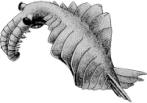 TOPICS IN PALEOBIOLOGY: HISTORICAL GEOLOGY, GLY
5655
TOPICS IN PALEOBIOLOGY: HISTORICAL GEOLOGY, GLY
5655
Prof.
Laurel Collins
Spring 2014, MWF 2-2:50am, DM 193
Course Description – The physical and biological history of Earth are inextricably intertwined into one great dynamic system. The first half of the course (covering chapters 1-10) investigates the basic principles and processes for understanding Earth’s history, including the rock cycle, biodiversity and the classification of life, environments of sediment deposition, correlation and dating of the rock record, evolution and the fossil record, plate tectonics and global geochemical cycles. The second half (chapters 11-20) applies the principles to interpreting Earth’s history and future.
Course Objectives – To understand how tectonic, climatic and biological systems have affected one another through time, from Earth’s origins until the near future.
Learning Outcomes –
Instructor – Dr. Laurel Collins, Department of Earth and Environment, and Department of Biological Sciences, email collinsl@fiu.edu, telephone 305-348-1732, office hours Mondays and Fridays 9:30-11am in PC 435. If a course or work conflicts with regular office hours, please make an appointment.
Textbook – Stanley, Steven M., 2009, Earth System History, 3rd ed., W.H. Freeman (at FIU bookstore $146 new, $110 used, $72 e-textbook rental). There is a separate Online Study Center package (http://bcs.whfreeman.com/esh3e) that is an excellent way to test yourself.
Course Policies on Attendance, Homework and Exams – Attendance at lectures is not required, but students who do not regularly attend lectures rarely learn enough to earn an A or B. It is a good idea to read in advance the textbook chapter we are discussing. We cover a lot of material and the homework assignment deadlines (1 week after the lecture) help you keep up with it. Students are expected to maintain high standards of academic honesty, and to answer homework and exam questions with their own work. Any student found in violation of these standards will earn an automatic F and be reported to the Provost's Office, no exceptions made. In accordance with FIU's policy on academic honesty, set forth in the Academic Affairs Policies and Procedures Manual (http://academic.fiu.edu/polman/sec2web.htm#two-forty-four), it is expected that students will neither submit the academic work of another as their own, nor provide work they have done for another student to be submitted as that student's work.
Research Paper - A paper on some aspect of historical geology, preferably relating to your own research, counts 100 points and is due at the last lecture on April 16. It should address a main thesis question (see handout on writing papers), and be at least 12 double-spaced pages including abstract, text and references, and excluding figures and tables.
Grading – The homework (hard copy only, typed or printed neatly) requires answering five questions at the end of each chapter using complete sentences. The deadline for homework is generally the beginning of the class 1 week following the chapter covered - see Homework Deadlines column, below. Assignments are worth 100 points total (20 chapters, 5 points/chapter, 1 point/question). Late assignments lose 1 point per week. The exams include questions requiring short answers/essays, and cover material since the last exam, except for the final that is cumulative. Makeup exams are given only in circumstances of personal emergencies for which you have documentable proof. The exams count 100 points each. Final grades are based on the following percentages of a possible total of 600 points: A = 93-100%, A- = 90-93%, B+ = 87-89%, B = 83-86%, B- =80-82%, C+ = 77-79%, C = 73-76%, C- =70-72%, D+ = 67-69%, D = 63-66%, D- =60-62%, F = 0-59%.